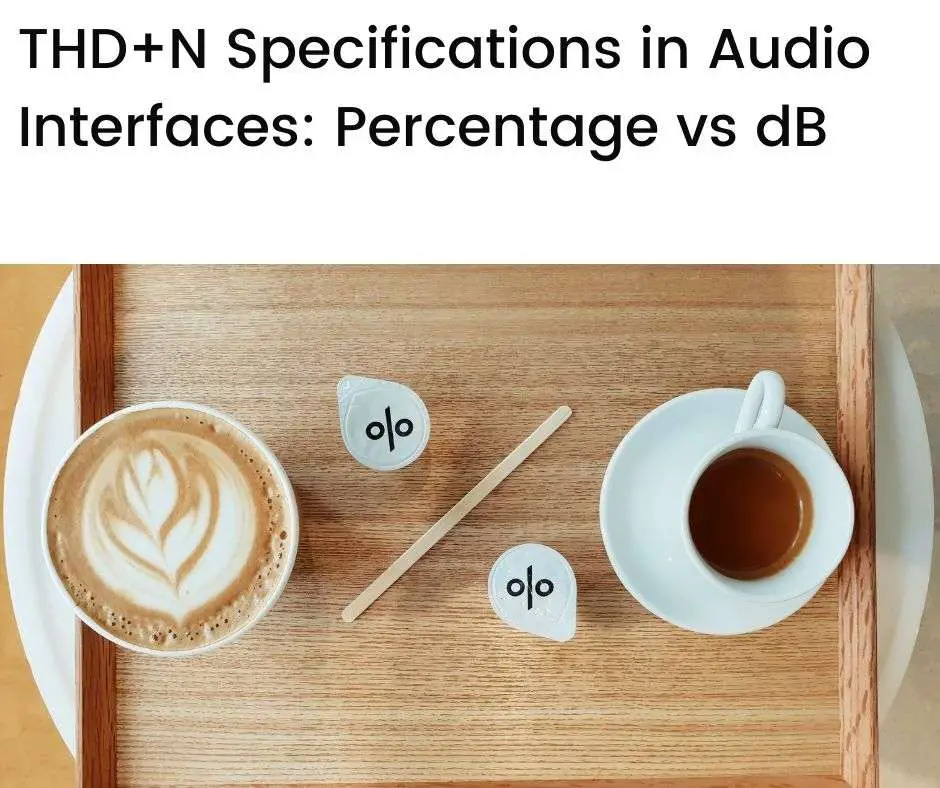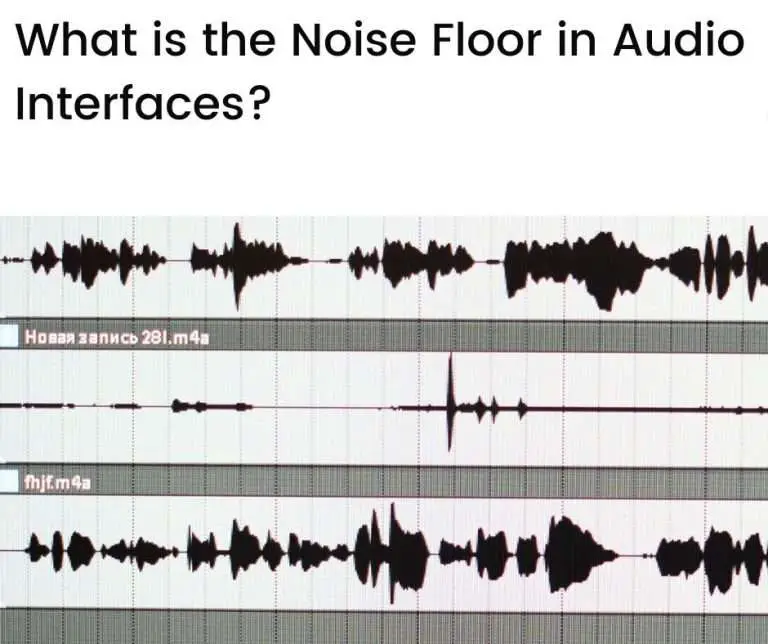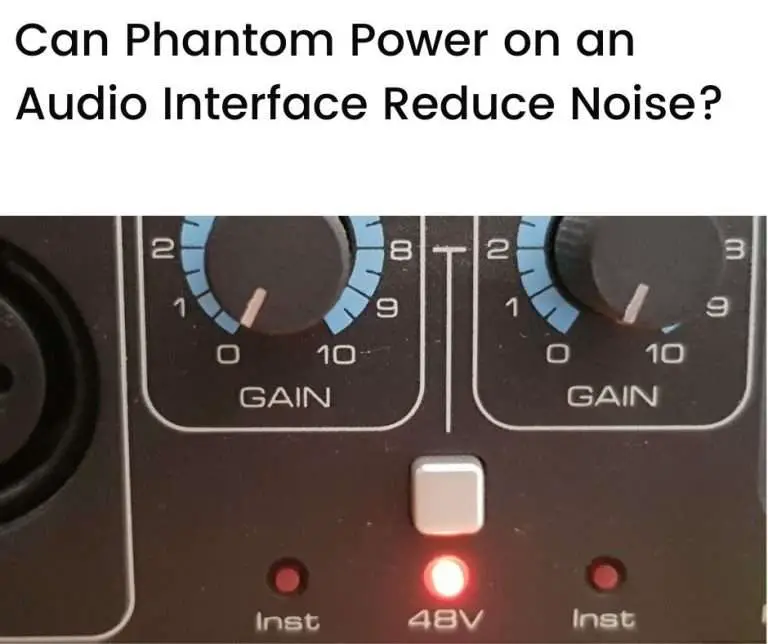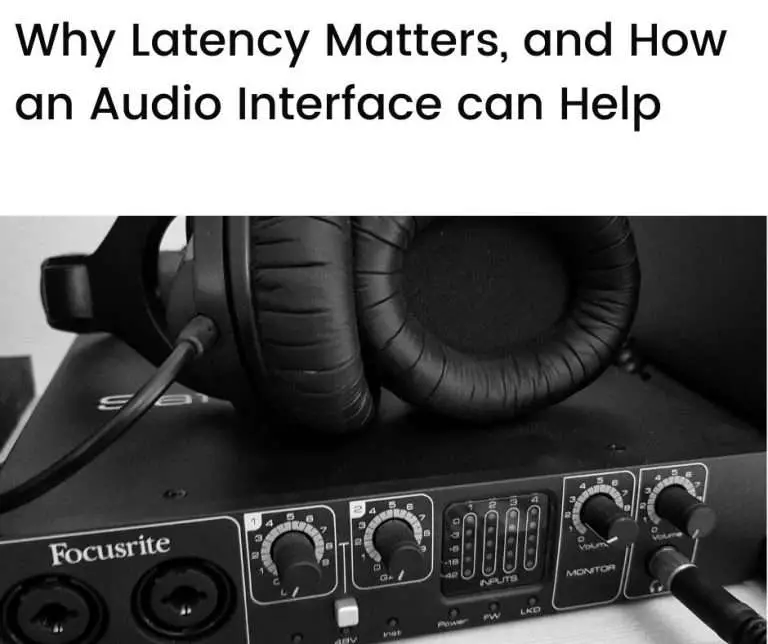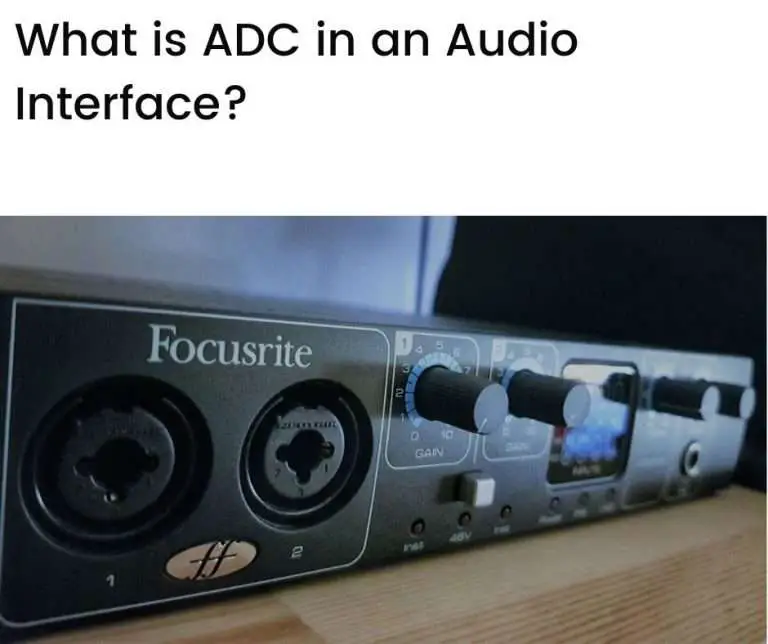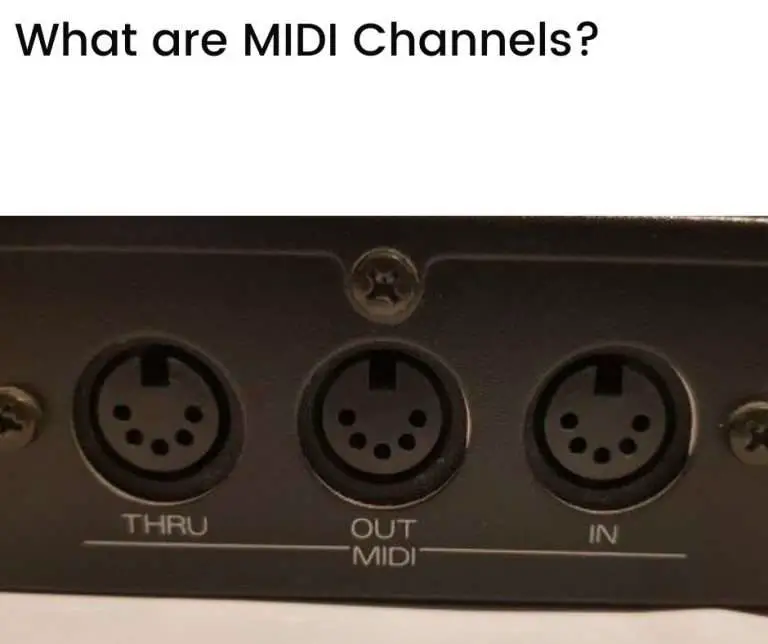Total harmonic distortion plus noise (THD+N) is a common metric in audio interface specifications. It measures the unintended harmonics and noise in an output signal relative to an input signal. Audio interface THD+N specifications are often quoted as either percentages (%) or ratios (dB). In this article, we look at the difference between these expressions of THD+N.
In this article we’ll look at:
- What is THD+N in audio interfaces?
- How is THD+N calculated?
- THD+N specifications in audio interfaces
- Conclusion
What is THD+N in audio interfaces?
Total harmonic distortion plus noise (THD+N) is a measure of the amount of unintended harmonic distortion and noise produced by an audio system.
The harmonics of a signal with a given frequency (say 1 kHz) are frequencies that are integer multiples of the signal’s frequency (eg. 3 kHz, 4 kHz, 5 kHz, etc.).
Harmonics arise in audio systems due to non-linearities in the electronics that make up the system.
THD+N calculations assume that all harmonics in a system are unintended. This is based on the idea that audio production systems are designed to faithfully reproduce signals from input to output, and should only change signals in ways that are intended.
THD+N includes noise in its calculation in addition to harmonics—if noise were excluded, then the calculation becomes a measure of total harmonic distortion (THD), another common specification metric, but which doesn’t include noise.
THD+N measures the energy of the harmonics and noise in an audio system relative to the energy of the input signal. Energy is often calculated as the root-mean-square of voltage amplitudes.
All else equal, the lower the THD+N value, the better.
In other words, the less unintended harmonics and noise generated by an audio system, relative to the input of the system, the better.
How is THD+N calculated?
THD+N is typically measured using a single-frequency input signal, say 1 kHz, and comparing its energy to the total energy at the output.
While there are various approaches to calculating THD+N, a common method is:
- Calculate the energy of the input frequency (eg. 1 kHz frequency) as it appears at the output
- Calculate the total energy of the output signal
- Subtract the energy of the input frequency from the total energy of the output signal
- Express the above result relative to the energy of the input frequency
We can summarize this as:
THD+N = (EOT – EOIF) / EOIF
Where,
- EOT is the total energy of the output signal
- EOIF is the energy (at the output) of the input frequency
THD+N specifications in audio interfaces
Most audio interfaces provide THD+N values in their specification notes—let’s look at a few.
Example THD+N specifications for popular audio interfaces
The table below shows the THD+N specifications for a range of popular audio interfaces—these values are taken from the owner manuals of the interfaces:
| Audio Interface | THD+N Specification (Line Inputs) | Measurement Parameters |
|---|---|---|
| Arturia Minifuse 2 | -100 dB | 1 kHz input signal |
| NI Komplete Audio 6 | 0.007% | not specified |
| Audient iD14 | 0.0017% | 0 dBu |
| Motu Ultralite-MK5 | -113 dB | 1 kHz input signal, 24 dBu, unweighted, unity gain |
| Solid State Logic SSL 2+ | < 0.0015% (-8 dBFS) < 0.005% (-1 dBFS) | 1 kHz input signal |
| M-Audio Air 192|14 | 0.001% | 1 kHz input signal, +4 dBu, -1 dBFS |
| PreSonus Studio 24c | 0.005% | 1 kHz input signal, -1 dBFS, min gain |
| Focusrite Scarlett 2i2 | < 0.002% | -1 dBFS, minimum gain, 22 Hz – 22 kHz |
THD+N specifications are typically provided for a range of inputs and outputs in audio interfaces—for the purposes of illustration, only the line input THD+N values are shown above.
What do you notice?
Firstly, some manufacturers specify their THD+N values as a percentage, whereas others specify THD+N values using a ratio in decibels (dB).
Secondly, to varying degrees, manufacturers list measurement parameters along with their THD+N specifications. These include the input frequency (eg. 1 kHz), the level of the input signal (eg. -1 dBFS), the bandwidth measured (eg. 22 Hz – 22 kHz), and the gain applied (eg. minimum gain).
To make like-for-like comparisons between THD+N specifications, the measurement parameters of each specification being compared should be the same.
The above list of THD+N specifications shows that many manufacturers do not provide sufficient information about measurement parameters.
Nevertheless, as most manufacturers tend to follow similar measurement processes, for the purposes of this article, we’ll assume that the THD+N specifications are comparable in terms of measurement parameters.
Converting THD+N percentages to ratios
As mentioned, some THD+N values are specified as percentages and others as ratios—how do you compare them?
It can appear confusing to see THD+N expressed in both percentages and ratios. But these different forms of expression are essentially the same—percentages and ratios (dB) are different ways of expressing the same thing.
Recall the standard definition of decibels, or dB:
dB = 20log10(V1/V2)
Where, V1 and V2 are the voltage (amplitudes) of the signals being compared.
For THD+N measurements, we could write this formula as:
dB = 20log10(rmsVH+N / rmsVInput)
Where, rmsVH+N and rmsVInput are the rms values of the harmonics and noise at the output, and the rms value of the input frequency (at the output) respectively.
Now, consider a situation where rmsVH+N is about a hundred times smaller than rmsVInput.
In other words, the energy of the harmonics and noise at the output of an audio system (or circuit) is only 1% of the energy at the input frequency of the output.
Hence, rmsVH+N / rmsVInput in this case is 1%, or 0.01.
Using the above formula for dB, our calculation in this situation would be:
dB = 20log10(rmsVH+N / rmsVInput)
= 20log10(1%)
= 20log10(0.01)
= -40 dB
We’ve just converted a percentage value of THD+N to an equivalent dB value—it’s that simple.
This same principle applies whenever you see THD+N specifications quoted as either a percentage value or in dB—you can convert between the two in order to compare the specifications.
The table below shows the conversion to dB for a range of common percentage values:
| Percentage | Equivalent Ratio (dB) |
|---|---|
| 10% | -20 [= 20log10(10%)] |
| 5% | -26.02 |
| 1% | -40 |
| 0.5% | -46.02 |
| 0.1% | -60 |
| 0.05% | -66.02 |
| 0.01% | -80 |
| 0.005% | -86.02 |
| 0.001% | -100 |
What do you notice?
While the percentages decrease in multiples (since 10% to 1% is a ten-fold decrease), the dB values decrease linearly (since -20 to -40 to -60, etc, are fixed increments).
Hence, the dB scale is a convenient way of expressing logarithmically changing values in a linear manner—this makes dB easier to work with.
As it happens, the dB scale is well-suited for audio applications since the apparent loudness (sound pressure) of many real-world sounds tends to increase (or decrease) logarithmically.
You’ll also notice that the dB values are negative. This is because the ratios being measured are percentages, ie. they are fractions of 1.
So, when applied to THD+N specifications, a negative dB value tells us that the harmonics and noise energy levels are smaller than the energy level of the input frequency—which is exactly what we’d hope to see!
Let’s now turn to a specific example from our selection of audio interfaces.
Reconciling between percentages and dB for THD+N examples
Consider the Arturia Minifuse 2 audio interface. This has a THD+N specification of -100 dB.
From our conversion table above, we know that this is equivalent to saying that the THD+N specification is 0.001%. This actually places the Arturia Minifuse 2 as one of the best performing audio interfaces amongst our examples for THD+N (assuming comparable measurement parameters across the interfaces).
We can similarly convert all of our example audio interface THD+N specifications between percentages and dB—this is shown below (the figures in bold are the conversions from the original specification):
| Audio Interface | THD+N Specification—Percentage | THD+N Specification—dB |
|---|---|---|
| Arturia Minifuse 2 | 0.001% | -100 dB |
| NI Komplete Audio 6 | 0.007% | -83.10 dB |
| Audient iD14 | 0.0017% | -95.39 dB |
| Motu Ultralite-MK5 | 0.00022% | -113 dB |
| Solid State Logic SSL 2+ | 0.005% | -86.02 dB |
| M-Audio Air 192|14 | 0.001% | -100 dB |
| PreSonus Studio 24c | 0.005% | -86.02 dB |
| Focusrite Scarlett 2i2 | 0.002% | -93.98 dB |
Using the above table, you can now compare all of the THD+N specifications directly across our selection of audio interfaces, using either the percentage column or the dB column.
Keep in mind, however, that for a proper comparison between these interfaces you would also need to consider the measurement parameters used, to ensure that you’re making a like-for-like comparison in each case.
Conclusion
The total harmonic distortion plus noise (THD+N) is a widely used metric in audio interface specifications. It measures the extent of unintended harmonic distortion and noise present in an output signal relative to (the frequency of) the input signal.
All else equal, the lower the THD+N, the better.
THD+N specifications are typically expressed either in percentages (%) or ratios (dB). This can make it confusing to compare specifications across different audio interfaces.
But these different specifications are really different ways of expressing the same thing—percentages and dB ratios are interchangeable.
Using the standard formula for dB, it’s easy to convert THD+N specifications between percentage and dB values, which makes it easier to compare different specifications.
Keep in mind that, in practice, meaningful comparisons between THD+N specifications can only be made if the measurement parameters are consistent between the comparisons. Assuming this is the case, it’s easy to convert THD+N specifications between percentages and ratios so that they can be directly compared.

